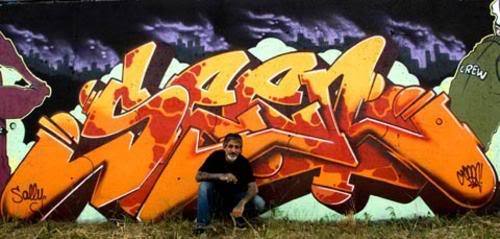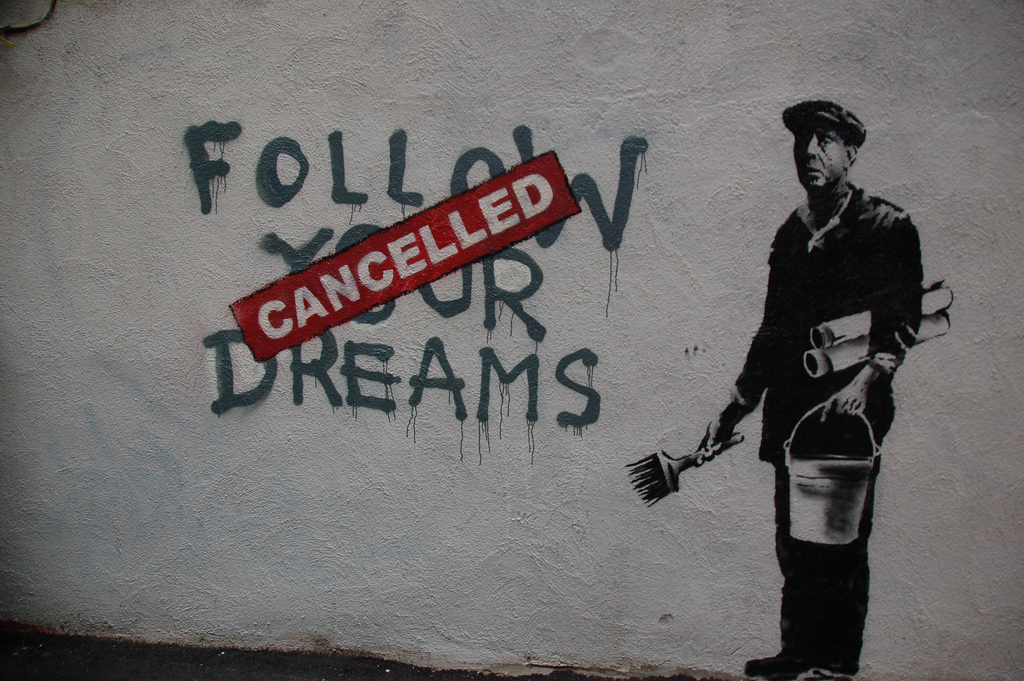I have always found graffiti to be beautiful, an adornment on an otherwise industrialized piece of a city, and yet I feel strangely indifferent to it. I am neither as passionate as the graffiti writers themselves, trying desperately to get their names out and make their mark, or as enraged as the uptight critics of said art, labeling it as destructive and an embarrassment to society. While watching "Style Wars", I felt almost that this passion was awkward and misplaced. Those who felt the need to leave something behind on government property were passionate about their work, and despite the beauty and precision with which they created dazzling names, that was it, names. These people weren't painting messages about social issues or trying to get a truly noble message across; they were trying to get their name out there. And the government officials were out of their minds trying to convince the viewers of how horrific graffiti is and how it ruins the lives of everyday people, yet again, all they were enraged about was simply artistic renderings of names and words. Graffiti is nothing more than a way for the public to leave their mark on society.
While these are all from New York circa the "Style Wars" era, there's plenty of graffiti all over the world.
France:
Portugal:
South Africa:
Thailand:
There is graffiti everywhere, and most of it is a name, most of which can barely be read due to their unique and nearly illegible font. (All images from here)
That being said, the concept is truly fascinating. At the amusement park I grew up near, there was one ride they kept constantly refurbishing as it got covered in etchings and scribbles of peoples names and initials and dates. As a kid, I always loved to look at this wall and see all these people's names and know they came and did the same rides and things that I was doing.
On a large scale, this almost relates to my major in anthropology. If cavemen and ancient populations hadn't left so many drawings and names on items and walls, we would be much more clueless to our past as a species, and all of the intrigue towards historical society would be left unfulfilled. I think it is human nature to want to leave a mark on the planet to be remembered by, and while we shouldn't necessarily celebrate most graffiti because it does, in a way, defile property that doesn't belong to the artist, at the same time, we shouldn't see it as entirely destructive, and offer outlets and places where graffiti is allowed to be expressed.
After doing all this research on names and traditional graffiti, learning more about Banksy was an interesting change. Banksy's graffiti seems a lot less basic-human-instinctual and more political and social commentary, which I definitely appreciate. It follows the human desire to leave his or her mark, but in a more selfless way.
Banksy clearly sees street art as a way to send a message and values its importance historically, the way I previously mentioned. I found the most fitting piece of Banksy art to be this, of a street cleaner cleaning off historical cave wall drawings.In the movie, a man attempts to sell a piece of Banksy art that he pilfered from whatever wall or building it was on. He goes through tons of effort and hundreds, potentially thousands of dollars, to restore and authenticate a tattered, raggedy piece of street art. The kicker is that he ends up selling it for thousands of dollars, when it costed him nothing to obtain and a fraction of the money he made to refurbish it. What he briefly entertains us with is the question of morality of his whole mission. After all, he did steal the art off of a wall. Was that ethically correct, since it was just put out for the public's enjoyment, and so he should be allowed to take it for his extra enjoyment? Or should it be left alone and be unsellable since it was put on the street to inspire those on the street, not only those who can afford it? Chris Thompson, the man behind the documentary, has the mentality that "If someone is putting art in front of you on the street and it's worth thousands of dollars, who says I can't take it?" And I think he isn't necessarily wrong; he can indeed take it as he showed us. The issue is somewhat over his misinterpretation of Banksy's message. I don't think Banksy wanted people to profit from his work in a monetary sense, but rather in an enlightening sense. That being said, if I saw a piece of street art I knew was worth thousands and I knew how to remove it and make it sellable, I would most certainly try to sell it. It's only human to want and need money, and I cannot quite judge his actions because I would probably do the same. If graffiti were normalized, I think people would feel less inclined to pilfer it and more inclined to appreciate it. Right now, people are trying to find the boundary between street art and sellable art, and until these lines are drawn, no one will know truly the legality of this uncharted territory.
As for the EyeWriter device, I think it is so incredibly ingenious. The fact that it is at all associated with graffiti is nearly irrelevant. It allows anyone at all with almost no mobility create art with their eyes, and that in and of itself is fascinating. I am truly interested to see how the world improves in similar ways, going forward. At what point does art, or even intelligence, become suddenly accessible to the entire world population? When does a disability become unable to disable a person due to the sheer expanse of science? Regardless, graffiti does have an impact on the world and society, and it is certainly an important aspect of everyday life and culture.






















No comments:
Post a Comment